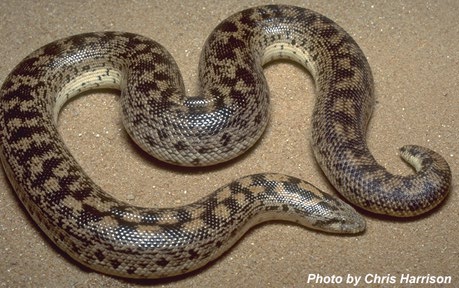
The Tartar Sand Boa (Eryx tataricus)
other images
head of adult female
adult male
7 other tataricus photos courtesy of Dave Sorensen
Introduction
The Tartar Sand Boa is one the larger members of the genus Eryx. Adult females can reach 4 feet in
length. Like most other Sand Boas, adult males are considerably shorter, rarely reaching 30 inches (75 cm).
Ataev (1985) felt that a 20 inch (50 cm) adult was probably sexually mature. They have fairly typical
Sand Boa coloration of brown/green blotches on a tan/beige background. Some specimens show a wash of orange,
primarily along the midline of the neck.
Like other Central Asian snakes, there is little published information available on this species in the English literature.
The natural range of E. tataricus is somewhat difficult to figure out due to the difficulty some authors have
had defining this taxon. In general, this is a snake of the Steppe, found from the Caspian Sea east into western
China and maybe Mongolia (it is listed as Endangered in the
1987 Red Book of
Mongolia). Like most "sand" boas, this is not a snake of sandy deserts, but
rather one of the dry grasslands. In fact, in a
State
of the Environment report for the Republic of Tajikistan, E. tataricus is
listed as a species of the mountain foothills, and not the semi-desert.
It is known to utilize the burrows of rodents for hiding.
Tokar regards the two subspecies of this snake as separate species (E. tataricus and E. vittatus).
Kluge(1993) felt that there were two taxa in museum collections under the name tataricus, but felt that they
did not correspond to the ranges of the described subspecies tataricus and vittatus. This issue is
further complicated by the difficulty some authors have had distinguishing tataricus from both miliaris and jaculus.
In the captive population, most tataricus in the US are sold as Russian Sand Boas, but this common name is also
applied to jaculus and miliaris. Because of this, many owners of "Russian" Sand Boas don't
even know which species they have.
Strangely enough, I once received a rather unusual email about a species of sand boa in
Tajikistan (presumably tataricus)
that is supposedly used to cure "a terminal disease" (the writer wasn't specific as to which terminal disease) that
can not be cured with "modern medicine". I guess we will just have to watch the latest medical journals
for any updates! ;-)
After I wrote that last paragraph, rather tongue-in-cheek, I found a
link to this
story in Pravda (the Russian newspaper) about a man arrested for smuggling
12 E. tataricus out of Uzbekistan in bottles of flour to sell for
their "pharmaceutical properties" in western Siberia. Apparently they were
worth US$1000/dozen. Wow! That's a pretty high price for wild caught
snakes.
The Tartar Sand Boa in Captivity
Most Tartar Sand Boas in captivity in the US were wild caught snakes from areas of the former Soviet Republics.
In my experience, these are quite active snakes for Sand Boas and are frequently seen crawling about in their
enclosures. I doubt that wild E. tataricus are correspondingly active. I expect this is
simply a reflection of our inability to meet their needs in a captive environment.
Most E. tataricus that I have kept fed readily on small rodents (see the feeding
page). They are easy to maintain and very docile. Only young snakes and a few males show any inclination
to bite. Tartar Sand Boas, like other Eryx, will coil and flatten the posterior part of their body when
threatened (see picture of adult male for example of this
behavior).
Tartar Sand Boas have been bred in captivity on numerous occasions. The small neonates can be challenging to get feeding
on mice, but feed readily once established. They grow quickly and can reach sexual maturity in their fourth year.
© Chris Harrison
| 


